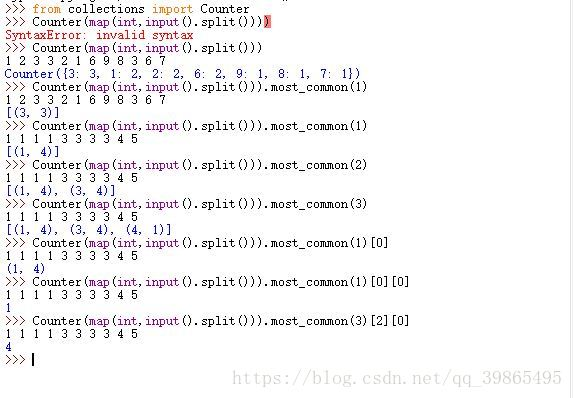方法1-np.argmax(np.bincount())
看一个例子
array = [0,1,2,2,3,4,4,4,5,6] print(np.bincount(array)) print(np.argmax(np.bincount(array))) #[1 1 2 1 3 1 1] #4
这里用到了两个函数,np.argmax和np.bincount,第一个很常见,就是返回数组中最大值对应的下标,np.bincount可以通过上面的例子理解:首先找到数组最大值max,然后返回0~max的各个数字出现的次数,在上例中,0出现了1次,1出现了1次,2出现了2次...以此类推。
为什么这两个函数合起来可以找到出现次数最多的元素呢?因为np.bincount返回的数组中的下标对应的就是原数组的元素值,如上例中np.argmax找到np.bincount返回的数组中的最大值3(原数组中4出现了3次),其对应的下标4正是原数组中的元素4,如此就可以找到数组中出现次数最多的元素。
但是这种方法有一个缺陷,即bincount只能统计0~max出现的次数,所以这种方法仅适用于非负数组
方法2-Counter().most_common(1)[0][0]
看一个例子
from collections import Counter
array = [0,1,2,2,3,4,4,4,5,6]
print(Counter(array))
print(Counter(array).most_common(1)[0][0])
#Counter({4: 3, 2: 2, 0: 1, 1: 1, 3: 1, 5: 1, 6: 1})
#4
Counter用来对数组中元素出现次数进行统计,然后通过most_common函数找到出现次数最多的元素。这种方法对于数组就没有过多限制,甚至是各种类型元素混合的数组也可以
from collections import Counter
array = [0,1,2,2,3,4,4,4,5,6,'aswd']
print(Counter(array))
print(Counter(array).most_common(1)[0][0])
#Counter({4: 3, 2: 2, 0: 1, 1: 1, 3: 1, 5: 1, 6: 1, 'aswd': 1})
#4
关于most_common函数可以通过下面的例子加深理解:

目前我只知道这两种方法,如果有大佬知道更多好用的办法,欢迎留言🙏:)